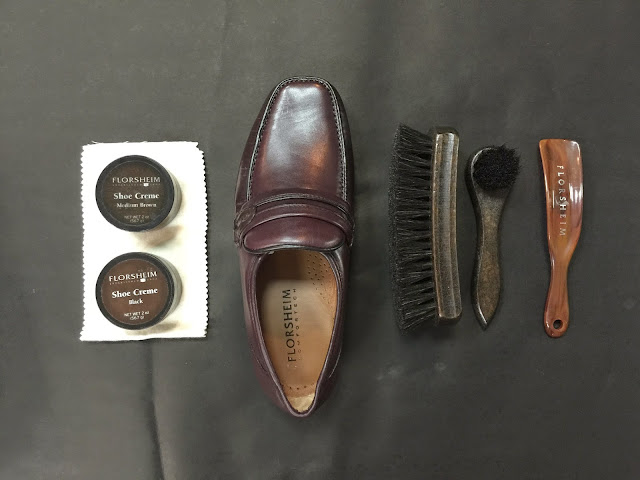 |
| ComforTech loafers |
The classics, in art and literature, are the epitomes of excellence,
original and groundbreaking during the time they came out, setting the standard
for other works to follow and influencing many others. Despite being created
many years ago, even hundreds of years before, they remain relevant. Their
appeal is timeless, and their beauty endures.
In fashion, trends come and go, but the classic styles remain. They may
be cast aside from time to time, but people return to them. There have been
numerous style changes in men’s shoes over the years. The toe gets very pointy
or stubby, for example. But the classic round toe is coming back, said Eric
Leung.
The regional executive of Florsheim also said that the ones that are
durable, comfortable and handsome in any season, with a mark of high quality,
will always have a market and will always return. Usually, these are made by
companies with a heritage of making shoes and innovation, such as
Florsheim.
Florsheim was founded in 1892 by Milton Florsheim with The Florsheim
Shoe Company in Chicago, Illinois, in the United States. Over the years, it
became an established brand as well as international name in footwear with
presence in Europe, Central America, South America and Asia.
In Asia, Florsheim stores can be found in China, Cambodia, Vietnam, Sri
Lanka, Bangladesh and the Philippines. It will soon open its first store in
Nepal and is eyeing Bangladesh. Leuing flew to the Philippines to grace the
opening of its tenth store in the country at the new mall Ayala Fairview
Terraces in Fairview, Quezon City.
Leung’s presence here highlighted the importance of the Philippine
market.
“The Philippines is the third biggest market in Asia-Pacific region,” he
said. “We see the relevance of our brand here and commit to continuously
address the fashion requirements of every Filipino, male and female.”
He mentioned that Hong Kong and mainland China remain the top two
markets of Florsheim. Hong Kong has over a hundred Florsheim stores, selling an
average of about 150 to 200 pairs of shoes a day.
The success of the brand in the Philippines is attributed to the strong
partnership of its local distributor, the Retail Specialist Inc (RSI).
“We have been partners with RSI for over 22 years now. Through them,
Florsheim is made available to the Philippine market, competitively priced,
timely displayed of the latest collection and strategically located in
prominent malls in Manila, Cebu and Davao,” Leung said.
Established in 1991, RSI also distributes the brands Naturalizer,
Mayoral and Justice, and operates 26 specialty retail stores in 13 malls
nationwide. The new Florsheim store will carry popular lines and products such
as Royal Imperial, Imperial, Florsheim Regular, Comfortech and Sports and
Casual, as all other stores do.
With the opening of the new store, Leung pushed the local campaign of
returning to the classics, highlighting the staples for men, such as the
wingtips, made with calfskin and kidskin and having sewn soles; loafers,
moccasins and other casual shows, all sewn by hands; and lace-ups, timed for
the opening of the school year. This is geared towards the professionals since
the bulk their clientele are professionals, 25 years old and up, who can afford
the brand, which is priced higher than many others.
They are also promoting the Comfortech shows, which was introduced in
the 1980s and having outsoles that are extra light and very flexible.
According to Leung, among the casual shoes, the weave has become a
popular style especially during summer. He sees through that men will be going
for rounder toe shapes with neutral tones such as cognac and taupe.
Leung is also highlighting the women’s shoes as Florsheim is mostly
known as a men’s brand. But he said that 50 percent of Florsheim’s shoes are
men’s, while the women’s take the other half. Surprisingly, the women are their
number-one customers rather than men. This is because, he said, women tend to
buy more shoes and more often. Men usually buy shoes when the ones they have
are worn out.
He predicted the man shoe and ankle bootie to become popular, with the
flats gradually coming back into fashion for the women’s footwear.
Florsheim has also developed shoes in brighter colors to keep abreast of
the changing fashion and to attract new and younger customers. Colors to check
out this season are classic blue, moss green, orange, lemon and pink, and
beige, maroon and grey.
But Leung said that consumers will also continue to look for comfort,
flexibility and durability when buying quality, classic and fashionable shoes.
He said: “We have a rich heritage incomparable to others. Our focus
remains on designing sophisticated, elegant and contemporary shoes that cater
to all walks of life. We make our shoes using leading-edge technology and
superior workmanship that results in exceptional quality, comfort and styling
that people around the world have grown to love for the past more than 120
years.”
Florsheim stores in the Philippines are located at TriNoma Mall,
Shangri-La Plaza Mall, Glorietta 4, SM Mall of Asia, Festival Mall Alabang,
Alabang Town Center, Ayala Fairview Terraces, Ayala Center Cebu, Abreeza Mall
Davao and SM City Davao. For more information, follow them through Facebook
(Florsheim Philippines), Twitter and Instagram (@FlorsheimPH), or log on www.retailspecialistinc.com/brands/Florsheim.



































.JPG)















































